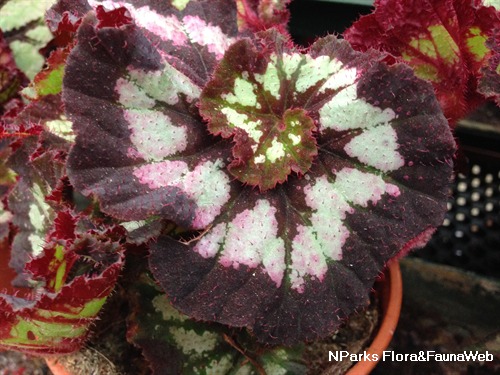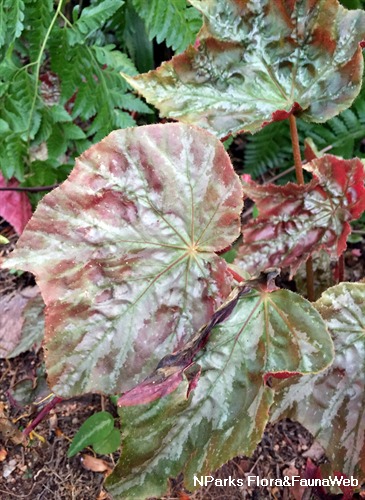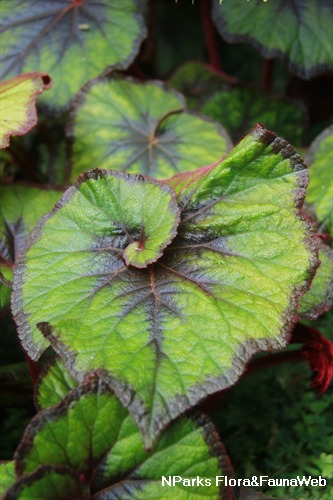
Back
Begonia rex-cultorum
| Family Name: | Begoniaceae |
| Common Name: | Rex Begonia, King Begonia, Painted-leaf Begonia, Beefsteak Geranium, 大王秋海棠 |
Name
Classifications and Characteristics
| Plant Division | Angiosperms (Flowering Seed Plants) (Dicotyledon) |
|---|---|
| Plant Growth Form | Herbaceous Plant |
| Lifespan (in Singapore) | Perennial |
| Mode of Nutrition | Autotrophic |
| Plant Shape | Compact |
| Maximum Height | 0.3 m to 0.5 m |
Description and Ethnobotany
| Others - Plant Morphology | Growth form: Perennial herb with fleshy, horizontal rhizomes that often grow aboveground. Begonia rex was discovered in Assam, India. In the 1850s, it was introduced to the horticulture industry and crossed with other Begonia spp.. Today's hybrids originate from these crosses. Foliage: Leaves come in a wide variety of shapes, colours and patterns. Shapes include asymmetric, ovate, cordate and palmately lobed. Colours may have a metallic sheen, while patterns may consist of spots, stripes, swirls or streaks. Leaf size varies from 8 - 30 cm long. They usually have serrate or lobed leaf margins. Flowers: Flowers are pale pink. Male and female flowers occurs on the same plant. Flowers occur above the leaves on tall, erect stalks. Fruits: The dry, dehiscent fruits are known as capsules. The fruits are winged and split lengthwise to release the seeds. Landscaping: The foliage of Begonia rex hybrids comes in bright colours and bold patterns. They can be used to add colour to flower beds and borders in shady locations. They grow well in containers and can be used to decorate shady spots on a balcony or patio. Hybrids are also often grown indoors. Plants will last for years under optimal growing conditions, providing long-lasting enjoyment. Cultivation: This species grows best under bright filtered lighting, as direct sunlight will cause leaf scorch. Indoor plants that are placed in dim lighting may lose their bright colours and become more green. Plant in well-drained, porous soil, because the rhizome is prone to rotting in waterlogged soil. Allow the soil to dry between waterings. Keep the leaves dry to prevent leaf spot. Fertilize plants every two weeks with quarter-strength balanced complete liquid fertilizer (23-19-14). Plants will grow best in a humid environment. Leaf tips and margins that become brown is a sign of insufficient humidity. Increase humidity by placing potted plants on a tray of wet pebbles or using a room humidifier, but ensure adequate air flow to prevent fungal diseases, such as mildew and botrytis. Hybrids are also susceptible to mealy bugs. Optimum growth temperature for this species is about 18 to 24 °C. Pinch the branch tips to prevent plants from becoming leggy. Propagation: Propagate by leaf cuttings, stem cuttings, or rhizome division. This species is typically propagated by leaf cuttings. It has a high success rate, and new plants are formed in about 6 months. This method involves cutting leaves in multiple places across leaf veins. The leaf pieces are laid flat on the planting medium, and plantlets will form along the cut edge. Stem cuttings will root in about 20 days under optimal conditions. Although this species may also be propagated by seed, it is time-consuming and the daughter plants are likely to differ from the parent plant. Etymology: The genus "Begonia" was named after Michel Begon (1638 - 1710), a French patron of botany and former governor of Haiti (then called Santo Domingo). The specific epithet "rex" is derived from the Latin word "regere" which means king. |
|---|
Landscaping Features
| Desirable Plant Features | Ornamental Foliage |
|---|---|
| Landscape Uses | Suitable for Hanging Baskets, Container Planting, Interiorscape/ Indoor Plant |
Plant Care and Propagation
| Light Preference | Semi-Shade |
|---|---|
| Water Preference | Moderate Water |
| Plant Growth Rate | Moderate |
| Rootzone Tolerance | Fertile Loamy Soils, Well-Drained Soils |
| Maintenance Requirements | High |
| Propagation Method | Stem Cutting, Leaf Cutting, Division |
Foliar
| Mature Foliage Colour(s) | Black, Brown, Green, Purple, Red, Silver / Grey |
|---|---|
| Mature Foliage Texture(s) | Smooth, Rough |
| Foliar Type | Simple / Unifoliate |
| Foliar Arrangement Along Stem | Alternate |
| Foliar Shape(s) | Non-Palm Foliage (Ovate, Palmate, Cordate, Asymmetrical) |
| Foliar Venation | Palmate |
| Foliar Margin | Palmately Lobed, Serrate / Toothed |
| Foliar Apex - Tip | Acute |
| Foliar Base | Rounded / Obtuse |
| Typical Foliar Area | Mesophyll ( 45cm2 - 182.25 cm2 ), Macrophyll ( 182.25cm2 - 1640.25 cm2 ) |
Non - Foliar and Storage
| Stem Type & Modification | Herbaceous |
|---|---|
| Root Type | Underground (Tap Root) |
| Specialised Storage Organ(s) | Underground (Rhizome) |
Floral (Angiosperm)
| Flower & Plant Sexuality | Unisexual Flowers , Monoecious |
| Flower Colour(s) | Pink |
|---|
| Flower Symmetry | Bilateral |
Fruit, Seed and Spore
| Fruit Classification | Simple Fruit |
|---|---|
| Fruit Type | Dehiscent Dry Fruit , Capsule |
Image Repository
Others
| Master ID | 427 |
|---|---|
| Species ID | 1723 |
| Flora Disclaimer | The information in this website has been compiled from reliable sources, such as reference works on medicinal plants. It is not a substitute for medical advice or treatment and NParks does not purport to provide any medical advice. Readers should always consult his/her physician before using or consuming a plant for medicinal purposes. |




